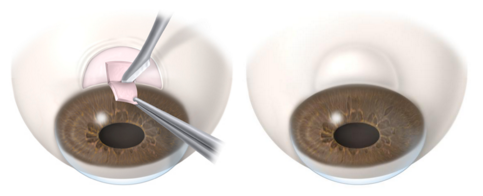Laser treatment or surgery is offered to patients whose disease condition has not been well-controlled with medications or who suffer adverse reactions to medications.
What Kinds of Laser Surgery Are Performed For Glaucoma?
Laser surgeries lower intraocular pressure by enhancing the drainage of aqueous fluid or slowing its production. In angle closure glaucoma, a laser peripheral iridotomy is performed to widen the drainage angles and improve aqueous flow from behind the iris to the front of the eye.
In some open angle glaucomas, selective laser trabeculoplasty can help reduce eye pressure. This improves aqueous drainage by clearing the microscopic debris in the drainage angles. Patients may still need to continue their glaucoma eyedrops to control the eye pressure after the laser treatment and sometimes a repeat laser procedure is required.
Some patients require laser cyclophotocoagulation which destroys the cells in the eye that produces the fluid in the eye, thereby lowering the eye pressure. This is performed as a day surgery procedure under local anaesthetic with sedation. This is especially useful if the eye pressure is very high despite maximum medications and it is not suitable to perform other forms of surgery.
Glaucoma Surgery
What Types Of Surgery Are Performed For Glaucoma?
Trabeculectomy is performed as a day surgery procedure, under local anaesthetic with sedation to help a patient feel more comfortable. It can be performed alone or in combination with cataract surgery. A small opening is created in the wall of the eye allowing fluid from inside the eye to flow out and be contained in a bubble under the eyelid. This will lower the eye pressure and protect the optic nerve from damage. The normal scarring and healing response of the body can cause the surgery to fail because the egress of fluid from the inside of the eye is obstructed. A special medicine, mitomycin C, is applied at the time of surgery to try to prevent this. The patient continues to use antibiotic and steroid eyedrops for a few months after surgery but often does not need to use their glaucoma eyedrops.
 |
Glaucoma tube implant surgery is performed if trabeculectomy surgery is likely to fail, for example if vigorous scarring is expected after surgery or if the eye has previously undergone surgeries. This is also done as a day surgery procedure under local anaesthesia with sedation. It can also be done alone or in combination with cataract surgery. A small silicone implant is stitched to the wall of the eye with tube entering the front of the eye. This allows fluid from inside to drain out and be contained in a bubble under the eyelid.
Minimally Invasive Glaucoma Surgery (MIGS)
Minimally Invasive Glaucoma Surgery (MIGS) is new surgical option that involves implanting very small implants like the iStent Trabecular Micro-Bypass stent and the Hydrus Microstent into the eye.
What do these implants do?
They create a permanent opening that bypasses the blockage in the drainage system to improve the eye’s natural fluid outflow. This reduces the eye pressure to prevent damage to the nerve at the back of the eye, thus preventing blindness.
Are they effective in lowering eye pressure? Are they safe to use?
These implants are approved by the US Food & Drug Administration (FDA) and the Health Sciences Authority (HSA) in Singapore.
In randomised clinical trials comparing patients who underwent combined MIGS and cataract surgery against cataract surgery alone, patients with MIGS and cataract surgery achieved significantly greater eye pressure reduction than cataract surgery only. More of them required fewer eyedrops to control their eye pressure or were able to stop medications for up to 2 years than the latter group. The surgical complications were similar in frequency and number between both combined MIGS and cataract surgery compared to cataract surgery alone.
In the COMPARE study comparing implantation of Hydrus vs implantation of 2 iStents, the Hydrus proved to be superior in reducing eye pressure and the number of glaucoma eyedrops required after surgery.
Who Should Undergo the Surgery?
MIGS is indicated in patients with Open Angle Glaucoma and can be implanted at the same time that a person is undergoing cataract surgery. It can also be used in those who previously had cataract surgery. MIGS can be considered in glaucoma patients with
- Eye pressure inadequately controlled with eyedrops and/ or laser treatment
- Adverse/ allergic reactions to eyedrops
Being minimally invasive, the reduction in eye pressure may be less than conventional glaucoma surgery. However, the advantages of MIGS are:
- Less complications
- Relatively quick recovery time
- Good patient comfort
- Conventional glaucoma surgery can still be performed in future if needed
After glaucoma surgery, patients should return for regular check up visits so they can receive appropriate and timely treatment for complications that arise.